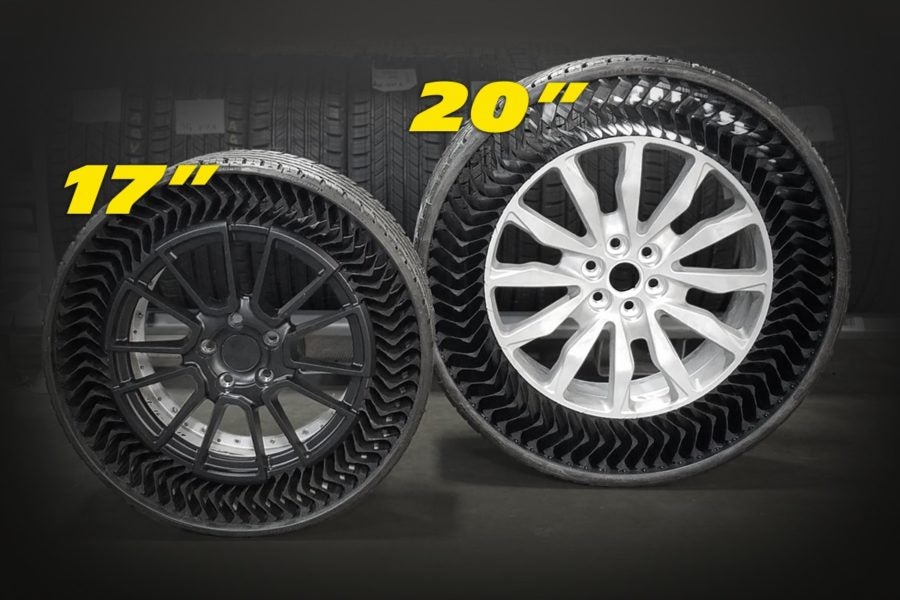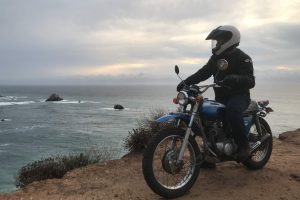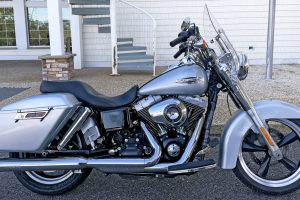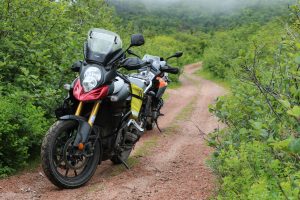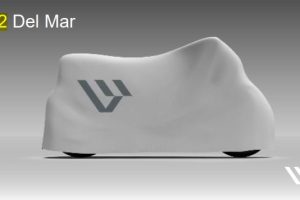I thought it was about time I brought myself and you up to speed on the latest scientific advances and discoveries with application to motorcycling.
Uptis is a word that looks odd. It means, however, that the Michelin Man should be puncture-proof in future. Good ol’ Mich is working with General Motors on this tire called the Unique Puncture-proof Tyre System, or Uptis, which should be in production by 2024.
The odd-looking tyre which holds no air and has springy rubber arms rather than sidewalls is said to be inherently safer than regular rubber. And because they won’t rupture or wear irregularly, airless tyres also have the potential to be much greener than what we currently use. Although “we” in this case seems to mean drivers; motorcyclists might not be ready for the potentially… interesting… behaviour of the Uptis tyres in corners.

Bend that battery! And incorporate it anywhere on the bike.
On the other hand, production of thin, flexible batteries which have the potential to be incorporated into things like motorcycle fairings is well under way. No bike manufacturer has picked up on them yet, surprisingly, but you can already buy small ones for US$15 from China. Time for a new garage business creating electric bikes powered by their own fairings? Maybe with some of those new graphene-based solar cells to make the bike independent of charging points?

Graphene has more properties than Donald Trump.
Remember that graphene is 200 times stronger than steel and far lighter so there have to be applications in all parts of a bike. Maybe the battery could be incorporated the way some bikes carried their oil in the frame. Perhaps not in the swingarm, with apologies to Erik Buell. Yes, I know graphene is expensive but so was aluminium once. You probably don’t remember this, but it was so precious that it was used for jewellery. Mass production arrived and now we drink from aluminium soft drink cans — and then throw them away.
On to the latest discovery from the Korea Advanced Institute of Science and Technology in South Korea, reported in New Scientist magazine by Leah Crane. Hyung Jin Sung and his team have been looking at stingrays, trying to work out the hydrodynamics of their odd shape.

Their google eyes make stingrays faster rather than slowing them down.
The smooth, flexible fins of the rays make them highly efficient swimmers, but their eyes and mouths stick out, breaking the smooth silhouette. You would think (if you weren’t Hyung Jin Sung) that these protuberances would create drag and interfere with their smooth motion, slowing them down. But you would be wrong. The opposite is true: their bulging faces allow stingrays to swim even more efficiently and faster.
The scientists used a series of hydrodynamic simulations to determine the effect that the rays’ eyes and mouths have on their propulsion. They found that the protrusions created vortices as the rays moved through the water. One vortex pushed water towards the back of the ray, creating an area of lower pressure in front of it. That allows the rays to swim faster without extra effort.
Another vortex pushed water to the sides, increasing the pressure below the ray while decreasing the pressure above it. That increased the efficiency of every stroke of the fins, generating more thrust – once again without extra effort from the ray. The most surprising thing about this, according to Sung, was the magnitude of the increase in efficiency caused by the vortices. The eyes increased efficiency by a huge 20.5 percent, while the mouth added 10.6 percent.
This is truly amazing. Try to imagine the effect on a motorcycle’s performance if the fairing design added more than 30 percent to its aerodynamic efficiency! There have only ever been tentative attempts at designing motorcycles resembling stingrays, such as Ducati’s Paso and Honda’s CBR1000F Flying Condom. It’s time to revisit the idea, but preferably in a somewhat more attractive form.
While both of the above ideas have considerable potential in motorcycle design and operation, there is another report in New Scientist that may address a serious problem in the motorcycle industry: the lack of sufficient numbers of competent bike mechanics.

Your mechanic has just flown in.
Mark O’Hara and Berenika Mioduszewska of the University of Veterinary Medicine in Vienna have found that Goffin’s cockatoos (Cacatua goffiniana) studied in Indonesia not only use tools but make their own. This is the first known instance of wild, non-primate animals making and using tool sets.
Here’s why they do it. Goffin’s cockatoos are the only species known to eat sea mangos. When they were offered the fruit, two cockatoos “grabbed a sea mango and flew into a tree to strip wood from the branches with their beaks. Using their tongues and beaks, the parrots crafted wood slivers into usable tools of three different sizes and thicknesses,” O’Hara says. The thinnest tools were sharp like knives, the medium-sized tools worked like spoons and the thickest tools could function like a wedge.

Cacatua goffiniana not only uses tools, it makes its own. Suck on that, SnapOn!
这也许可以解释一些精致、漂亮的customising work coming out of Indonesia Just imagine. What if, with a bit or retraining, we could get Goffin’s cockatoos to work on motorcycles? They would easily match the skill level of some of the apprentices we’ve seen and there would be no need to wait for the Snap-On Tools man to come by because they could make their own tools! We would just have to get them to switch from wood to something stronger.
Presumably they’d work for birdseed, too, or maybe sea mangos.
(Photos Wikimedia Commons unless otherwise noted)


